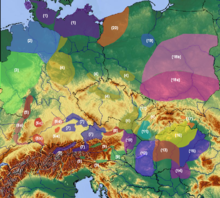Hatvan culture
 | |
| Geographical range | Hungary, Slovakia |
|---|---|
| Period | Bronze Age |
| Dates | 20th-18th centuries BC |
| Type site | Nagyrév |
| Preceded by | Nagyrév culture |
| Followed by | Ottomány culture, Mad'arovce culture |

The Hatvan culture was a
Cserehát Hills, later expanding into northern Hungary and the Tisza valley, and the Tiszazug area in Eastern Hungary.[2] The end of Hatvan culture was associated with the expansion of the Ottomány culture
.
Burials
Burials were carried out via cremation. Ashes were either scattered into the grave pit, or buried in a funeral urn. Vessels with food and beverages were buried along with the deceased. Burial sites were placed closer to settlements during the Hatvan period than in the previous Nagyrév period.
Settlements
Over 100 Hatvan Settlements have been identified; often built between 5-10 Kilometers apart. These settlements were often fortified; containing long rectangular houses made of
timber and daub. In the last century of the early Bronze Age, Hatvan settlements were carefully planned, with houses being placed around an open, centralized location. Houses were often around 12 meters in length during this early settlement stage.[3] Fortifications consisted of ditches and ramparts. It was named after Hatvan, Hungary.[4] It is believed that the Hatvan culture came into conflict with the Füzesabony culture, based upon the site at Jászdózsa–Kápolnahalom. The settlement was purposefully burned, indicated by the presence of thick layers of burnt debris in every house uncovered at this site. Hidden under the floor of one house were over 140 grams of ornaments including; bronze axes, amber beads, and gold hair ornaments. The center of this site has a 4 meter deep sacrifice pit, which contains the remains of brown bears, aurochs, boar, deer, and pigs. Hatvan Pottery was largely textile and Barbotine ware. Their fortified inhabited settlements were mainly located in the Bükk region and the Mátra
region.
See also
- Unetice culture
- Bronze Age Britain
- Argaric culture
References
- ISBN 9638629185.
Named after the Hatvan–Strázsahegy site in northern Hungary where the culture evolved, the Hatvan culture was a neighbour of the Nagyrév culture. The Hatvan culture evolved from the intermingling of earlier local communities and eastern population groups. The earliest upland settlements of the culture are known from the Cserehát Hills, lying between the Hernád–Bodrog–Sajó rivers; the culture later expanded into northern Hungary and the Tisza valley down to the Körös rivers, as well as eastern Hungary, including the Tiszazug area. Over one hundred Hatvan settlements fortified with ditches and/or ramparts, often lying at distances of no more than 5–10 km from each other, were established in the wake of this expansion. The Hatvan communities brought an end to the Nagyrév culture, and rebuilt the destroyed Nagyrév settlements according to their own tradition.
- ^ "Archived copy" (PDF). Archived from the original (PDF) on 2018-12-22. Retrieved 2018-05-17.
{{cite web}}: CS1 maint: archived copy as title (link) - ^ http://www.ace.hu/am/2015_2/AM-2015-2-FK.pdf [bare URL PDF]
- ^ "Hatvan Culture - Oxford Reference".
{{cite journal}}: Cite journal requires|journal=(help)
External links
![]() Media related to Hatvan culture at Wikimedia Commons
Media related to Hatvan culture at Wikimedia Commons
